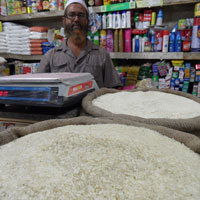Rice is the staple food of more than half of the world’s population, with more than 700 million tons produced annually (equivalent to 470 million tons of milled rice). Although most rice is consumed in the countries where it is produced, a growing demand in some areas is feeding the international rice trade.
Most of the rice is grown and consumed in Asia, from Pakistan in the west to Japan in the east. ‘Rice-producing Asia’ – defined as Asia excluding Mongolia and the countries of Central Asia – accounts for roughly 90% of world rice production. But because it is a net exporter of rice to the rest of the world, its current share in global rice consumption is slightly less (87%).
Outside Asia, where rice is not a staple yet, per capita consumption continues to grow. In Africa, consumption has grown faster than production, so many countries must import their rice. Yet the gap between demand and supply in sub-Saharan Africa, where rice is grown and eaten in 38 countries, reached 10 million tons of milled rice in 2008, costing the region an estimated $3.6 billion for imports. Western Africa is the main producing subregion, accounting for more than 40% of African production in 2006–2008.
Changes in rice availability and prices have caused social unrest in several countries. With further area expansion unlikely, global rice yields must rise faster than in the recent past if world market prices are to be stabilized at affordable levels for the billions of consumers. Before the 2008 food crisis, the prevalent real milled rice price was $300 per ton in international markets.

International rice markets
Unlike maize and wheat, most rice tends to be eaten where it is produced and so does not enter international markets. Yet, the volume of international rice trade has increased almost fourfold, from 7.5 million tonnes annually in the 1960s to an average of 28.5 million tonnes during 2000–2009.
In the international rice trade, a relatively small number of exporting countries must interact with a large number of importing countries. In the first decade of the 2000s, the top five exporters had 81% of the world market (up from 69% in the 1960s). Since the 1980s, Thailand has consistently been the world’s largest exporter of rice, followed by Vietnam and India.
 Because of the high concentration of exports coming from only a few countries, the international rice market is vulnerable to disruptions in supply from major exporting countries, leading to higher world prices. This means that a sudden change in production trade policy in one or more of these countries could have a major impact on world market flows and prices, such as occurred in the price crisis of 2007–2008.
Because of the high concentration of exports coming from only a few countries, the international rice market is vulnerable to disruptions in supply from major exporting countries, leading to higher world prices. This means that a sudden change in production trade policy in one or more of these countries could have a major impact on world market flows and prices, such as occurred in the price crisis of 2007–2008.
In contrast to exports, imports of rice are widely dispersed across countries. The five main rice-importing countries in the first decade of the 2000s (Philippines, Nigeria, Iran, Indonesia, and the European Union) accounted for only 27% of total global rice imports; and the share of the top 10 countries was only 44%. However, because of market segmentation, some of the larger rice importers have had major impacts on world rice prices. Large purchases by state trade in the Philippines in 2007 and 2009 demonstrated how an individual importer could contribute greatly to world price destabilization. Indonesia’s rice imports accounted for 10% and 15% of world trade in the 1960s and 1970s, respectively (and 7.4% and 9.2% of national net availability). During these years, Indonesia’s imports had major impacts on world rice markets.
Looking ahead
A number of other countries are expecting to begin or increase rice exports in the near future, such as Argentina, Brazil, Cambodia, and Myanmar. In sub-Saharan Africa, where nearly half of the rice is imported, big opportunities exist to expand production, replace costly imports, and help offset malnutrition and poverty. Latin America, with its ample land and water resources, may ultimately become transformed into a major exporter of rice, thus helping to stabilize the global rice market.
 More rice exports from a larger number of countries will help buffer future trade against some of the causes of instability that have been described. However, world prices are likely to remain unstable, as production shocks occur or trade policies change in the major exporting countries. Climate change could also contribute to the instability in prices, depending on how it affects productivity in rice-producing countries.
More rice exports from a larger number of countries will help buffer future trade against some of the causes of instability that have been described. However, world prices are likely to remain unstable, as production shocks occur or trade policies change in the major exporting countries. Climate change could also contribute to the instability in prices, depending on how it affects productivity in rice-producing countries.
Lingering pessimism about the reliability of international markets in the wake of the international price crisis of 2007–2008 may slow growth in the rice trade. This could change if proposals to reduce international price fluctuations are adopted.
Ultimately, poor rice consumers and net rice-deficit farmers in rice-importing countries generally benefit from trade because of lower prices and greater availability. For these hundreds of millions of households, as well as for rice producers in exporting countries, continued expansion of world trade in rice would enhance welfare and promote food security.



